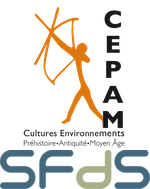Programme > Conférenciers invitésIA-MA pour l'histoire et la philologie : Speaker : Mathieu Aubry (École des Ponts Paris Tech) Exposé : Computer Vision for Historians: examples Préface : In this presentation, I will give an overview of recent projects my team did on Historical document analysis and outline the main associated challenges and approaches. Applications will include works artwork auction price prediction [1], historical document segmentation [2], historical watermark recognition [3], repeated patterns discovery in artworks [4,5,6], scientific illustration analysis [7], handwriting analysis for paleography [8]. I will discuss in particular methods to avoid relying on large-scale human annotation of the datasets - the use of synthetic data, weak supervision, self or unsupervised approaches - but also the importance of annotations to define tasks and for evaluation. [1] Biased auctioneers, M Aubry, R Kraeussl, G Manso, C Spaenjers, Journal of Finance 2022
[2] docExtractor: An off-the-shelf historical document element extraction, T. Monnier, M. Aubry, ICFHR 2020
[3] Large-Scale Historical Watermark Recognition:dataset and a new consistency-based approach X. Shen, I. Pastrolin, O. Bounou, S. Gidaris, M. Smith, O. Poncet, M. Aubry ICPR 2020
[4] Discovering Visual Patterns in Art Collections with Spatially-consistent Feature Learning, X. Shen, A. Efros, M. Aubry, CVPR 2019
[5] Learning Co-segmentation by Segment Swapping for Retrieval and Discovery, X. Shen, A. Efros, A. Joulin, M. Aubry, ArXiv 2021
[6] RANSAC-Flow: generic two-stage image alignment, X. Shen, F. Darmon, A. Efros, M. Aubry, ECCV 2020
[7] Image Collation: Matching illustrations in manuscripts, R. Kaoua, X. Shen, A. Durr, S. Lazaris, D. Picard, M. Aubry, ICDAR 2021
[8] The Learnable Typewriter A Generative Approach to Text Line Analysis, Y. Siglidis, N. Gonthier, J. Gaubil, T. Monnier, M. Aubry, arXiv 2023
IA-MA pour l'art et l'archéologie du bâti : Speaker : Aleksandra Pizurica (Ghent University) Exposé : Artificial Intelligence in digital painting analysis Information processing in support of art investigation is an emerging and rapidly growing cross-disciplinary field of research. Museums are routinely digitizing their collections in multiple imaging modalities. Next to standard digital images of artwork, such as digital photographs, infrared and X-ray images, new sensing technologies are being developed and employed together with advanced techniques for analysing multimodal data. The progress in artificial intelligence (AI) and particularly in deep learning opens new, unprecedented possibilities for supporting technical study of art works, their conservation, and even the process of creation and interactive immersive presentation. AI-driven techniques are increasingly employed not only to authenticate artworks, but also to uncover their hidden details and connections to other works, to enhance viewing experience and to improve understanding of various layers of a masterpiece. In this talk I will present our results in the analysis of digitized paintings, and how they are employed to support art conservation and restoration, as well as art historical study. The focus will be on the case study of the Ghent Altarpiece and on the experience gained from a multidisciplinary collaboration in the framework of the recent major research and conservation campaign conducted on the Van Eyck brothers’ masterpiece.
IA-MA pour les matérieux du passé : Speaker : Gabriele Gattiglia (University of Pisa) Exposé: Managing AI in Archaeology: opportunity and challenges The advent of Artificial Intelligence (AI) applications within archaeology has brought incredible opportunities but also significant challenges. Only a few years ago, Machine Learning algorithms and Neural Networks were concepts unknown to archaeologists; now, AI has been applied to many archaeological fields, from the detection of archaeological sites, the recognition and reassembling of archaeological pottery, the mining of text from historical documents and epigraphs, the study of human remains, the identification of murals and graffiti, and even robotics. AI has great potential to create a better comprehension of shared archaeological heritage. In general, archaeology benefits from AI when a large amount of data must be analysed and when complex, highly specialised and time-consuming activities are required. However, despite popular perception, one of AI's most problematic aspects is not the algorithm's development but the creation of the dataset used to train it.
Therefore, together with a thorough knowledge of technical aspects, a more profound understanding of which archaeological research questions could be addressed, the availability and creation of the data upon which this research relies, the ethical, epistemological and hermeneutics side of the challenges that AI poses, and the lack of access to the necessary resources to undertake this work and its sustainability deserve more in-depth discussion and exploration.
IA-MA pour la modélisation des systèmes socio-environnementaux : Speaker : Andreas Angourakis (Rühr Universitat Bochum (RUB)) Exposé : Simulation, Machine Learning, and their Synergy in Addressing Past Socio-Environmental Systems
|


